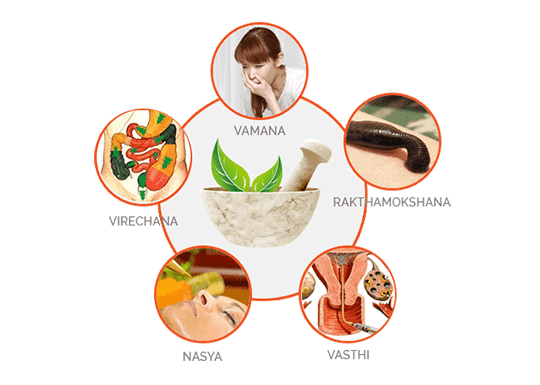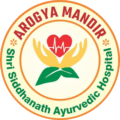Panchkarma

I. Introduction
In the realm of Ayurveda, an ancient system of medicine, Panchkarma stands out as a profound therapeutic approach. With roots deeply embedded in the wisdom of Ayurvedic principles, Panchkarma offers a holistic path to detoxify and rejuvenate the body, mind, and spirit.
II. Principles of Panchkarma
Panchakarma holds immense significance in Ayurveda, often regarded as the cornerstone of therapeutic interventions. While some may perceive Ayurvedic therapies solely through the lens of Panchakarma, it’s crucial to acknowledge the diverse range of treatments offered by Ayurveda. These therapies play a vital role in either reducing or eliminating doshas from the body.
Among the various Ayurvedic therapies, five specific ones stand out, collectively known as Panchakarma: Vaman (Emesis), Virechan (Purgation), Basti (Enema), Nasya (Pouring medicine in the nose), and Raktamokshan (Removing blood). Each of these therapies targets specific doshas—Kapha, Pitta, and Vata, contributing to the overall balance and well-being of an individual.
III. Components of Panchkarma
A. Vamana (Therapeutic Vomiting):
- Primarily aimed at removing Kapha dosha, Vaman involves induced vomiting, helping cleanse and balance the body.
- Conditions Treated:
- Kapha-related disorders such as respiratory conditions (asthma, bronchitis).
- Allergies and sinus congestion.
- Skin disorders like psoriasis and eczema.
- Chronic indigestion and obesity.
- Hypothyroidism
B. Virechana (Purgation):
- Focused on eliminating Pitta dosha, Virechan employs purgative measures to promote detoxification and balance.
- Conditions Treated:
- Pitta-related disorders like acidity and digestive issues.
- Skin diseases such as acne and dermatitis.
- Liver disorders and jaundice.
- Chronic constipation and inflammation.
C. Basti (Enema):
- Targeting Vaat dosha, Basti utilizes enema techniques to expel excess toxins and restore equilibrium in the body.
- Conditions Treated:
- Vaat-related disorders like arthritis and joint pain.
- Constipation and digestive issues.
- Back pain and sciatica.
- Nervous system disorders.
D. Nasya (Nasal Administration):
- Involving the administration of medicinal substances through the nasal passage, Nasya aims to remove doshas from the head region.
- Conditions Treated:
- Sinusitis and nasal congestion.
- Migraines and headaches.
- Neurological disorders.
- Hormonal imbalances and insomnia.
E. Raktamokshana (Bloodletting):
- This therapy is specifically designed to eliminate dosha-defected blood, contributing to overall purification.
- Conditions Treated:
- Skin disorders such as eczema and psoriasis.
- Chronic infections in the blood.
- Gout and other joint-related issues.
- Conditions involving impure or toxic blood.
V. Yearly Panchkarma
Panchakarma proves beneficial in treating various diseases at specific stages and is recommended for maintaining the health of a normal individual. Ayurveda recognizes the natural fluctuations of doshas during different seasons and suggests corresponding Panchakarma therapies:
- Vasant (January to March): Vaman therapy is recommended during spring to address increased Kapha dosha.
- Varsha (Rainy season): Basti therapy is suggested during the rainy season to counter elevated Vaat dosha.
- Sharad (October to December): Specific Panchakarma therapies are advised in autumn to manage dosha imbalances.
Every procedure is different thus we have explained it in separate post. Please find it below.
Raktamokshan
Click to know more
FAQs
Panchakarma may not be suitable for individuals of various ages and health conditions. Consultation is must before any Panchkarma
- The frequency depends on individual health goals, but an annual session is common for maintenance.
- When conducted by trained professionals, Panchkarma is generally safe, with minimal side effects.
- While some practices like Nasya can be done at home, it’s crucial to consult with an Ayurvedic practitioner for a comprehensive approach.
Uniqueness of our therapies
At Arogya Mandir – Shri Siddhanath Ayurvedic Hospital, Miraj, we delve deeply into the ayurvedic examination of each patient. Utilizing noninvasive Ayurvedic diagnostic tools such as Ashtavidha Parikshan and Nadi Parikshan, we precisely determine the pathogenesis of the disease and then prescribe therapies tailored to the specific condition. This approach leads to expedited results.
Our therapies boast the following distinctive features:
– Tranquil and hygienic therapy rooms staffed with trained therapists in a positive environment.
– Selection of appropriate massage oil based on the patient’s Prakruti and the condition of the disease.
– Complimentary Prakruti and Dhatu Sarata examinations before the commencement of therapies.
– Authenticated procedures for each therapy.
– Judicious use of herbal medicines and instruments during the therapy sessions.
– Specialized rooms equipped with all facilities for inpatient care.
Feel free to share this article at no cost.
Copyright message – Dr. Prashant Chivate has published this article on drchivateayurved.org for informational purposes about diseases. Any other use of this article is strictly prohibited. All rights reserved.
